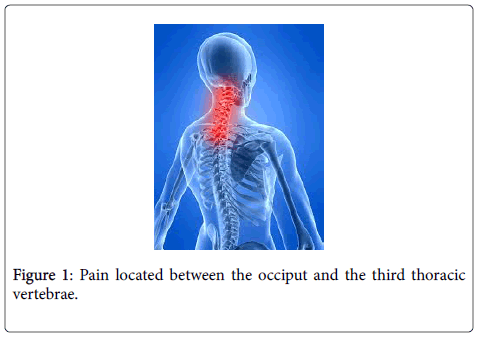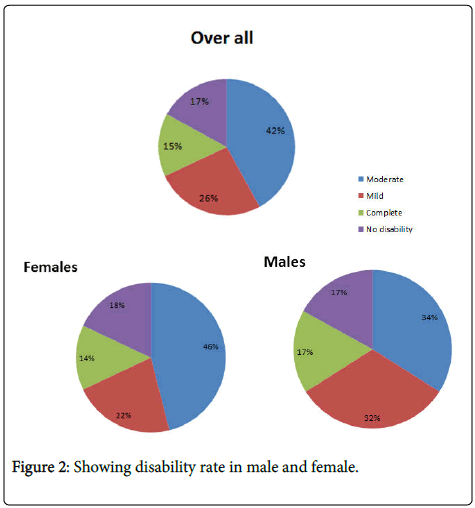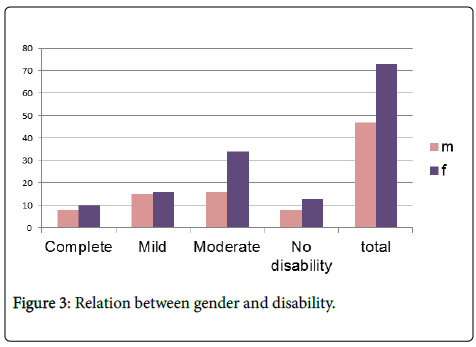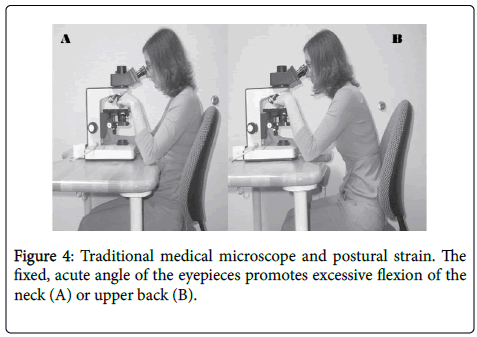Research Article Open Access
Prevalence of Neck Pain in Laboratory Technicians
Heta Patel1* and Urja Pandya21Shrimad Rajchandra College of Physiotherapy, Uka Tarsadiya University, India
2KM Patel Institute of Physiotherapy, SP University, India
- Corresponding Author:
- Heta Patel
Lecturer, Shrimad Rajchandra College of Physiotherapy
Uka Tarsadiya University, India
Tel: +919429182898
E-mail: patelrutu7943@gmail.com
Received Date: November 24, 2016; Accepted Date: March 30, 2017; Published Date: April 07, 2017
Citation: Patel H and Pandya U (2017) Prevalence of Neck Pain in Laboratory Technicians. J Nov Physiother 7:340. doi: 10.4172/2165-7025.1000340
Copyright: © 2017 Patel H, et al. This is an open-access article distributed under the terms of the Creative Commons Attribution License, which permits unrestricted use, distribution, and reproduction in any medium, provided the original author and source are credited.
Visit for more related articles at Journal of Novel Physiotherapies
Abstract
Aim the present study was to determine the prevalence of WMSDs in laboratory Personnel. Objective of the study was to evaluate the main health disorders (Neck Pain) of laboratory workers. Both male and female and laboratory personnel having worked experience of one or more than one year were included in the study. Laboratory personnel having any pathology related to neck and recent trauma or surgery to neck or shoulder were excluded from the study. Cross sectional descriptive study using a self-administered questionnaire was used. Laboratory personnel having work experience of one or more than one year were taken. An informed written consent was taken from the laboratory personnel who fulfilled the inclusion criteria. They were asked to fill a self-administered questionnaire which was then evaluated. The total number of participants was 120. The mean age was 28 years and the overall disability rate was 82.5%. The reasons for developing neck pain can be due to Cumulative trauma disorders (CTD) or repetitive strain injuries (RSI) or occupational overuse syndromes (OOS) of the musculoskeletal system or work related musculoskeletal disorders. These situations often lead to development of overuse syndromes, persistence of symptoms thus becoming recurrent and/or chronic. Thus, Neck pain is significantly prevalent in laboratory a personnel who is dependent on gender as well as BMI and not dependent on years of experience.
Keywords
Work related musculoskeletal disorders; Cumulative trauma disorders; Repetitive strain injuries; Occupational overuse syndromes
Introduction
Neck pain
Neck pain (NP) is a major public health problem, with two-thirds of the population having neck pain at some point in their lives which affects both personal health and overall well-being [1-3] as well as indirect expense [1,4,5]. The association of prolonged microscope use with the development of chronic pain syndromes has been recognized for nearly 3 decades; yet most pathologists are not well-informed about this hazard until after they develop a problem [6,7]. Although increased neck and back pain have been anecdotally reported by biomedical microscopes for more than a century [6]. The prevalence of work related musculoskeletal disorders (WRMSDs) is high in Laboratory technicians; they show high prevalence of neck pain, shoulder pain, elbow pain and hand pain. Neck pain is associated with the amount of fixed working postures. According to the world health organization (WHO) technical report, the management of WRMSDs determines to a largest possible extent the global productivity and work performance of working age adults. By this study we were be able to find out the prevalence of neck pain in laboratory personnel. This study will help further to improve their quality of life and establish the evidence with regards to their better outcome. The Aim of this study was to determine the prevalence of WMSDs (Work Related musculoskeletal disorders; Neck Pain) in laboratory Personnel. Objective of the study was to evaluate the main health disorders (Neck Pain) of laboratory workers (Figure 1).
Materials and Methods
Study design
Cross sectional descriptive study using a self-administered questionnaire. Study was done in Laboratory personnel having work experience of one or more than one year. There was 120 students participated in this study. Study was done on laboratory personnel working in Shree Krishna Hospital and Community. Study was conducted from October 2013-March 2014 [9,10]. In this study both male and female were included. Laboratory personnel having working experience of one or more than one Year were included. Laboratory personnel having any pathology related to neck, recent trauma or surgery to neck or shoulder were excluded. An informed written consent was taken from the laboratory personnel’s who fulfilled the inclusion criteria. They were asked to fill a self-administered questionnaire which was then evaluated. The Neck Disability Index (NDI) is designed to measure neck-specific disability. The questionnaire has 10 items concerning pain and activities of daily living including personal care, lifting, reading, headaches, concentration, work status, driving, sleeping and recreation [11-13]. The measure is designed to be given to the patient to complete, and can provide useful information for management and prognosis of those with neck pain. Each item is scored out of five (with the no disability response given a score of 0) giving a total score for the questionnaire out of 50. Higher scores represent greater disability [13,14]. The result can be expressed as a percentage (score out of 100) by doubling the total score [8].
Results
The total numbers of participants were 120 out of which there were 73 females and 47 males. The mean age of both males and females was 28 years and the overall disability rate was 82.5%. The total numbers of participants were 120 out of which there were 73 females and 47 males. The mean age of both males and females was 28 years and the overall disability rate was 82.5% (Figures 2 and 3, Tables 1 and 2).
| Complete | Mild | Moderate | No disability | P-value | |
|---|---|---|---|---|---|
| Under Weight | 3 | 7 | 14 | 2 | |
| Normal | 14 | 12 | 29 | 16 | |
| Over Weight | 1 | 9 | 5 | 2 | 0.068 |
| Obese | 0 | 3 | 2 | 1 | |
| Total | 18 | 31 | 50 | 21 |
Table 1: Relation between BMI and disability.
| Complete | Mild | Moderate | No disability | P-value | |
|---|---|---|---|---|---|
| Male | 8 | 15 | 16 | 8 | |
| Female | 10 | 16 | 34 | 13 | 0.772 |
| total | 18 | 31 | 50 | 21 |
i.e. mean disability scores of males and females are not equal.
Table 2: Relation between gender and disability.
• Coefficient of correlation between disability scores and years of experience r=0.109 Ho=Disability scores and years of experience are uncorrelated.
• p value for t-test=2.29E-20 which is much less than 0.05 therefore null hypothesis is accepted. i.e. disability scores and years of experience are uncorrelated.
Discussion
There were total 120 participants out of which 73 were females and 47 were females with mean age of 28 years and mean BMI of 22. Out of the total population 82.5% were suffering from neck pain. Females had greater prevalence of neck pain than the males.
The reasons for developing neck pain can be due to Cumulative trauma disorders [15] (CTD) or repetitive strain injuries [16] (RSI) or occupational overuse syndromes [17] (OOS) of the musculoskeletal system or work related musculoskeletal disorders [18] (WRMSDs) are defined as series of micro traumatic events that accumulate in the body as a result of workplace and work characteristics that in due course, have the potential to develop into a more serious injury to the musculoskeletal system.
Musculoskeletal disorders are present in 48% of work related disorders and diseases among patients visiting a general practitioner [19]. WRMSDs arise from repetitive work activities that normally are not hazardous, which become hazardous when the tissue loading exceeds its anatomical and physiological limits [20].
These situations often lead to development of overuse syndromes, persistence of symptoms thus becoming recurrent and/or chronic [21]. Tissue healing never actually gets accomplished since re injury occurs due to repeated exposure to occupational risk factors [22]. The physical ergonomic features of work frequently cited as risk factors for MSDs include rapid work pace and repetitive motion, forceful exertions, nonneutral body postures, and vibration [23].
Three general (not mutually exclusive) pathophysiologic mechanisms have been postulated as explanations for the development of CTDs:
i. Repetitive mechanical irritation,
ii. Microischemia, and
iii. Accumulation of metabolic products that promote inflammation or interfere with neuromuscular function [24-27].
Most proposed mechanisms feature a persistent and recurrent cycle of inflammation, tissue injury, and fibrosis leading to episodic pain and to dysfunction of muscles, ligaments, and fascia.
The third category also includes a growing body of evidence that increased levels of endogenous substances may interfere with neuromuscular function, activate local pain receptors, or cause hyper excitability of central nervous system pain responses [27-30]. In 1997, the National Institute for Occupational Safety and Health published a critical synopsis of evidence-based medical investigations into the associations between work activities and the development of MSDs [31].
There was strong evidence that high levels of static contraction, prolonged static loads, and awkward postures involving the neck and shoulder muscles were associated with an increased risk for MSDs (Figure 4).
The ischemic or toxic metabolite hypotheses are plausible explanations for the association of sustained postures with the development of MSDs. Most users have to flex the neck and upper back to view through the eyepieces. The neck and back muscles truly are working when we are sitting down viewing slides at the microscope or staring at a computer; this has been confirmed by surface electromyography [25]. In the sitting position, blood flow to these muscles may be suboptimal due to gravitational forces, lack of movement, and increased tension.
Relation of BMI and pain
Obesity is associated with increased production of cytokines and acute-phase reactants and with activation of pro inflammatory pathways [32] which in turn may lead to pain [33]. Obesity is associated with disc degeneration 34 and vertebral endplate changes [35]. Spinal mobility decreases with increasing body weight [36], which may interfere with disc nutrition.
Relation of gender and pain
A study on Japanese women published in the Hiroshima Journal of Medical Science noted in women that sloping shoulders and low muscle strength caused the weight of the arms and breasts to become a burden on neck and shoulder pain. They further indicated women may be more sensitive to pain in the neck and shoulders than men and women had a tendency to feel more stiffness. Hormones such as estrogen and testosterone affect the central nervous system, which is responsible for perceiving and transmitting the sensation of pain. This is one reason why conditions such as neck pain and headaches strike women at higher rates than men [36,37].
Conclusion
Neck pain is significantly prevalent in laboratory personnel’s which is dependent on gender as well as BMI and not dependent on years of experience.
References
- Cote P, Cassidy JD, Carroll L (2001) The treatment of neck and low back pain: who seeks care? who goes where? Med Care 39:956-967.
- Daffner SD, Hilibrand AS, Hanscom BS, Brislin BT, Vaccaro AR, et al. (2003) Impact of neck and arm pain on mean health status. Spine 28: 2030-2035.
- Toomingas A (1999) Characteristics of pain drawings in the neck-shoulder region among the working population. Int Arch Occup Environ Health 72: 98-106.
- Bassols A, Bosch F, Banos JE (2002) How does the general population treat their pain? A survey in Catalonia, Spain. J Pain Symptom Manage 23:318-328.
- Borghouts JA, Koes BW, Vondeling H, Bouter LM (1999) Cost-of-illness of neck pain in The Netherlands in 1996. Pain 80: 629-636.
- Brewster D (1835) Treatise on Optics. 2nd American ed. Philadelphia, PA: privately printed.
- Lorusso A, Bruno S, Caputo F (2007) Risk factors for musculoskeletal complaints among microscope workers (in Italian; abstract in English). G Ital Med LavErgon29:932-937.
- Vernon H, Mior S (1991) The Neck Disability Index: a study of reliability and validity. J Manipulative PhysiolTher 14:409-415.
- RiihimAki H (1991) Low-back pain, its origin and risk indicators. ScandJ Work Environ Health 17:81-90.
- Hagberg M, Wegman DH (1987) Prevalence rates and odds ratios of shoulder-neck diseases in different occupational groups. Br Ind Med 44:602-610.
- Kristensen TS (1995) The demand-control-support model: methodological challenges for future research. Stress Medicine 11:17-26.
- Bongers PM, de Winter CR, Kompier MAJ, Hildebrandt VH (1993) Psychosocial factors at work and musculoskeletal disease. ScandJl Work Environ Health 19:297-312.
- Ekberg K, Bjorkqvist B, Malm P, Bjerre-Kiely B, Karlsson M, et al. (1994) Case-control study of risk factors for disease in the neck and shoulder area. Occup Environ Med 51:262-266.
- Bernard B, Sauter S, Fine L, Petersen M, Hales T (1994) Job task and psychosocial risk factors for work-related musculoskeletal disorders among newspaper employees. Scand J Work Environ Health 20:417-426.
- HoutmanID, Bongers PM, Smulders PGW, Kompier MAJ (1994) Psychosocial stressors at work and musculoskeletal problems. Scand J Work Environ Health 20:139-145.
- Baker NA (1999) How useful is the term.cumulative trauma disorder? Work 13:97-105.
- Yassi A (1991) Repetitive strain injuries. Lancet.
- McNaughton H (2000) The label ‘occupational overuse syndrome’: Time to change. N Z Med J 113:193-194.
- Yassi A (2000) Work related musculoskeletal disorders. CurrOpinRheumatol12:124-130.
- Snashall D (1996) ABC of work related disorders: hazards of work. BMJ 313:161-163.
- Helliwell PS, Taylor WJ (2004) Repetitive strain injury. Postgrad Med J 80: 438-443.
- Tyrer SP (1999) Repetitive strain injury. Pain Rev 6:155-166.
- MacKinnon SE, Novak CB (1994) Clinical commentary: Pathogenesis of cumulative trauma disorder. J Hand Surg Am 19: 873-883.
- Punnett L, Wegman DH (2004) Work related musculoskeletal disorders: The epidemiological evidence and the debate. J ElectromyographKinesiol4: 13-23.
- 24) Larsson R, Oberg PA, Larsson S (1999) Changes of trapezius muscle blood flow and electromyography in chronic neck pain due to trapezius myalgia. Pain79:45-50.
- Larsson R, Oberg PA, Larsson S (1999) Changes of trapezius muscle blood flow and electromyography in chronic neck pain due to trapezius myalgia. Pain79:45-50.
- Falla D (2004) Unravelling the complexity of muscle impairment in chronic neck pain. Man Ther9:125-133.
- Solomonow M (2006) Sensory-motor control of ligaments and associated neuromuscular disorders. J ElectromyogrKinesiol16:549-567.
- Barbe MF, Barr AE (2006) Inflammation and the pathophysiology of work-related musculoskeletal disorders. Brain BehavImmun20:423-429.
- Gerdle B, Hilgenfeldt U, Larsson B, Kristiansen J, Sogaard K, et al. (2008) Bradykinin and kallidin levels in the trapezius muscle in patients with trapezius myalgia, in patients with whiplash associated pain, and in healthy controls: a microdialysis study of women. Pain139:578-587.
- Larsson B, Rosendal L, Kristiansen J, Sogaard G, Sogaard K, et al. (2008) Responses of algesic and metabolic substances to 8 h of repetitive manual work in myalgic human trapezius muscle. Pain 140:479-490.
- Bernard BP(ed.) Musculoskeletal Disorders and Workplace Factors: A Critical Review of Epidemiologic Evidence for Work-Related Musculoskeletal Disorders of the Neck, Upper Extremity, and Low Back. Atlanta, GA: Centers for Disease Control and Prevention, National Institute for Occupational Safety and Health; 1997.
- Millar NL, Wei AQ, Molloy TJ, Bonar F, Murrell GAC (2009) Cytokines and apoptosis in supraspinatus tendinopathy. J Bone Joint Surg Br 91:417-424.
- Karppinen J (2007) New perspectives on sciatica. In: DeLeo JA, Sorkin LS, Watkins LR (editors). Immune and Glial Regulation of Pain. Seattle, WA: IASP Press.
- Liuke M, Solovieva S, Lamminen A (2005) Disc degeneration of the lumbar spine in relation to overweight. Int J Obes (Lond)29:903-908.
- Tilg H, Moschen AR (2006) Adipocytokines: mediators linking adipose tissue, inflammation and immunity. Nat Re Immunol6:772-783.
- Kuisma M, Karppinen J, Haapea M, Niinimaki J, Ojala R, et al. (2008) Are the determinants of vertebral endplate changes and severe disc degeneration in the lumbar spine the same? A magnetic resonance imaging study in middle-aged male workers [electronic article]. BMC MusculoskeletDisord9:51.
Relevant Topics
- Electrical stimulation
- High Intensity Exercise
- Muscle Movements
- Musculoskeletal Physical Therapy
- Musculoskeletal Physiotherapy
- Neurophysiotherapy
- Neuroplasticity
- Neuropsychiatric drugs
- Physical Activity
- Physical Fitness
- Physical Medicine
- Physical Therapy
- Precision Rehabilitation
- Scapular Mobilization
- Sleep Disorders
- Sports and Physical Activity
- Sports Physical Therapy
Recommended Journals
Article Tools
Article Usage
- Total views: 3645
- [From(publication date):
specialissue-2017 - Aug 15, 2025] - Breakdown by view type
- HTML page views : 2706
- PDF downloads : 939




